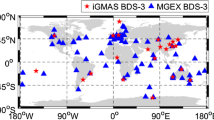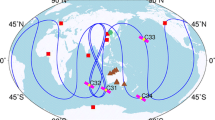Abstract
The yaw mode history of BDS-2 IGSO/MEOs since 2016 is inferred from reverse kinematic precise point positioning. Experimental results show that C06 (IGSO-1) and C14 (MEO-6) satellites have abandoned the orbit-normal (ON) attitude mode in favor of continuous yaw-steering (CYS) mode since March and September 2017, respectively. BDS C13 (IGSO-6), launched in March 2016, and C16 (IGSO-7) always adopt the CYS mode during eclipse seasons. The majority of BDS-2 IGSO/MEOs still experience attitude switches between nominal and ON mode. Most of the attitude switches from nominal to ON mode take place when the sun elevation angle above the orbital plane (β angle) decreases below 4° \((\left| \beta \right| < 4^\circ )\). A few switches also occur for \(\left| \beta \right|\) slightly above 4°. However, most of the attitude switches from ON to nominal mode are undertaken when \(\left| \beta \right|\) increases to above 4°, but a few switches with \(\left| \beta \right|\) just below 4° happen. The exact switch condition between the two attitude modes is presented in this study. For BDS-2 IGSO/MEOs using the CYS mode, the yaw-attitude model previously established by the Wuhan University (indicated by WHU model) can basically reproduce their yaw maneuvers. However, reverse midnight-turn maneuvers occasionally occur for C13 and C14 for β angles falling into the range \((0^\circ ,0.14^\circ )\). This discrepancy in the form of a reversal in the yaw direction during the noon-turn maneuvers is first observed for C13 and C14 when the β angle is in the range of \(( - \,0.14^\circ ,0^\circ )\). The mismodeling of the satellites attitudes during reverse yaw maneuvers significantly degrades the performance of BDS precise orbit determination (POD). The phase observation residuals extracted from BDS POD reach 40 cm, which thereby leads to the misidentification of a substantial number of observations around orbital midnight and noon points as outliers when the WHU model is applied in our experiments. The WHU model is modified to reproduce the reverse yaw maneuvers of satellites in the post-processing BDS POD. The derived phase residuals decrease to normal levels, and the clock solutions become smoother relative to solutions employing the WHU model.
















Similar content being viewed by others
References
Bar-Sever YE (1996) A new model for GPS yaw attitude. J Geod 70(11):714–723. https://doi.org/10.1007/BF00867149
Beutler G, Brockmann E, Gurtner W, Hugentobler U, Mervart L, Rothacher M, Verdun A (1994) Extended orbit modeling technique at CODE processing center of the international GPS service for geodynamics (IGS): theory and initial results. Manuscr Geod 19:367–386
Cao X, Zhang S, Kuang K, Liu T, Gao K (2018) The impact of eclipsing GNSS satellites on the precise point positioning. Remote Sens 10(1):94. https://doi.org/10.3390/rs10010094
Dai X, Ge M, Lou Y, Shi C, Wickert J, Schuh H (2015) Estimating the yaw-attitude of BDS IGSO and MEO satellites. J Geod 89(10):1005–1018. https://doi.org/10.1007/s00190-015-0829-x
Dilssner F (2017) A note on the yaw attitude modeling of BeiDou IGSO-6. a report dated November 20, 2017. http://navigation-office.esa.int/attachments_24576369_1_BeiDou_IGSO-6_Yaw_Modeling.pdf. Accessed 21 Sept 2018
Dilssner F, Springer T, Gienger G, Dow J (2011a) The GLONASS-M satellite yaw-attitude model. Adv Space Res 47(1):160–171. https://doi.org/10.1016/j.asr.2010.09.007
Dilssner F, Springer T, Enderle W (2011b) GPS IIF yaw attitude control during eclipse season. AGU Fall Meeting, San Francisco. http://acc.igs.org/orbits/yaw-IIF_ESOC_agu11.pdf. Accessed 9 Dec 2018
Dilssner F, Springer T, Schönemann E, Enderle W (2014) Estimation of satellite Antenna Phase Center corrections for BeiDou. In: Proceedings of IGS workshop 2014, June 23–27, Pasadena
Dilssner F, Laufer G, Springer T, Schonemann E, Enderle W (2018) The BeiDou attitude model for continuous yawing MEO and IGSO spacecraft. EGU 2018, Vienna. http://navigation-office.esa.int/attachments_29393052_1_EGU2018_Dilssner_Final.pdf. Accessed 10 Nov 2018
Ebert K, Oesterlin W (2005) Dynamic yaw steering method for spacecraft. European patent specification EP 1526072B1. http://www.freepatentsonline.com/EP1526072.pdf. Accessed 10 Jan 2019
Ge M, Gendt G, Dick G, Zhang FP (2005) Improving carrier-phase ambiguity resolution in global GPS network solutions. J Geod 79(1–3):103–110. https://doi.org/10.1007/s00190-005-0447-0
GSA (2017) Galileo satellite metadata. https://www.gsc-europa.eu/support-to-developers/galileo-satellite-metadata. Accessed 28 Sept 2018
Guo J, Zhao Q, Geng T, Su X, Liu J (2013) Precise orbit determination for COMPASS IGSO satellites during yaw maneuvers. In: Sun J, Jiao W, Wu H, Shi C (eds) Proc. China satellite navigation conference (CSNC) 2013, vol 245, pp 41–53. https://doi.org/10.1007/978-3-642-37407-4_4
Guo J, Chen G, Zhao Q, Liu J, Liu X (2017) Comparison of solar radiation pressure models for BDS IGSO and MEO satellites with emphasis on improving orbit quality. GPS Solut 21(2):511–522. https://doi.org/10.1007/s10291-016-0540-2
Kouba J (2009) A simplified yaw attitude model for eclipsing GPS satellites. GPS Solut 13(1):1–12. https://doi.org/10.1007/s10291-008-0092-1
Kouba J (2013) A note on the December 2013 version of the eclips.f subroutine. http://acc.igs.org/orbits/eclipsDec2013note.pdf. Accessed 2 Nov 2018
Kouba J (2017) Notes on December 2017 version of the ECLIPS subroutine. http://acc.igs.org/orbits/eclips_Dec_2017.tar. Accessed 23 Apr 2018
Kuang D, Desai S, Sibois A (2017) Observed features of GPS block IIF satellite yaw maneuvers and corresponding modeling. GPS Solut 21(2):739–745. https://doi.org/10.1007/s10291-016-0562-9
Liu Y, Jia X, Ruan R (2017) BeiDou IGSO satellite orbit precision analysis based on new attitude control mode. J Geodesy Geodyn 37(6):614–617. https://doi.org/10.14075/j.jgg.2017.06.012
Montenbruck O, Schmid R, Mercier F, Steigenberger P, Noll C, Fatkulin R, Kogure S, Ganeshan AS (2015) GNSS satellite geometry and attitude models. Adv Space Res 56(6):1015–1029. https://doi.org/10.1016/j.asr.2015.06.019
Montenbruck O et al (2017) The Multi-GNSS experiment (MGEX) of the International GNSS Service (IGS)—achievements, prospects and challenges. Adv Space Res 59(7):1671–1697. https://doi.org/10.1016/j.asr.2017.01.011
Sakic P, Mansur G, Viegs E, Männel B, Schuh H (2018) Toward a Multi-constellation combination: Improving the IGS orbit and clock combination software for MGEX products. In: Proceedings of IGS workshop 2018, Oct 28–Nov 2, Wuhan
Wang C, Guo J, Zhao Q, Liu J (2018) Yaw attitude modeling for BeiDou I06 and BeiDou-3 satellites. GPS Solut 22:117. https://doi.org/10.1007/s10291-018-0783-1
Wanninger L, Beer S (2015) BeiDou satellite-induced code pseudo-range variations: diagnosis and therapy. GPS Solut 19(4):639–648. https://doi.org/10.1007/s10291-014-0423-3
Wu JT, Wu SC, Hajj GA, Bertiger WI, Lichten SM (1993) Effects of antenna orientation on GPS carrier phase. Manuscr Geod 18:91–98
Ye S, Xia F, Zhao L, Xia P, Chen D (2017) Impact analysis of yaw attitude on BDS precise point positioning. Acta Geod Cartogr Sin 46(8):71–977. https://doi.org/10.11947/j.AGCS.2017.20170094
Zhao Q, Wang C, Guo J, Wang B, Liu J (2018) Precise orbit and clock determination for BeiDou-3 experimental satellites with yaw attitude analysis. GPS Solut 22:4. https://doi.org/10.1007/s10291-017-0673-y
Acknowledgments
Thanks are due to Chen Wang and Xiaolei Dai for valuable discussion about RKPPP algorithm. We are grateful to the anonymous reviewers for their helpful constructive suggestions and comments which significantly improved the paper quality. This work is partially supported by the National Natural Science Foundation of China (Nos. 41704032, 41074008, 41431069, 41604028), National Science Fund for Distinguished Young Scholars (No. 41525014), Special Innovative Major project of Hubei Province (No. 2018AAA066), Postdoctoral Science Foundation of China (No. 2018M642911), and National Key Research and Development Program of China (No. 2018YFC0823704). Finally, the IGS MGEX are greatly acknowledged for providing the multi-GNSS data.
Author information
Authors and Affiliations
Corresponding authors
Additional information
Publisher's Note
Springer Nature remains neutral with regard to jurisdictional claims in published maps and institutional affiliations.
Rights and permissions
About this article
Cite this article
Xia, F., Ye, S., Chen, D. et al. Observation of BDS-2 IGSO/MEOs yaw-attitude behavior during eclipse seasons. GPS Solut 23, 71 (2019). https://doi.org/10.1007/s10291-019-0857-8
Received:
Accepted:
Published:
DOI: https://doi.org/10.1007/s10291-019-0857-8




